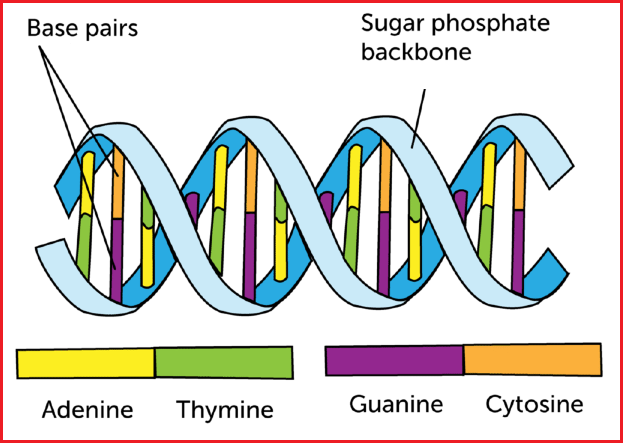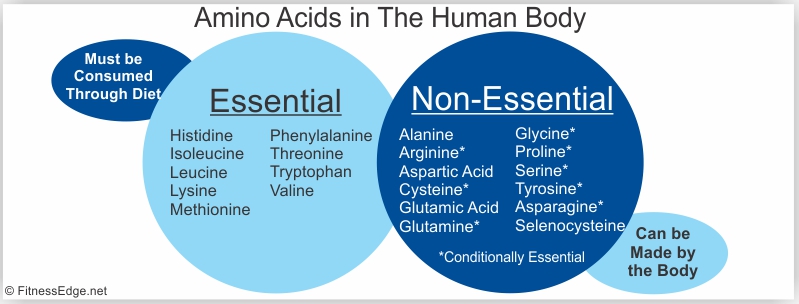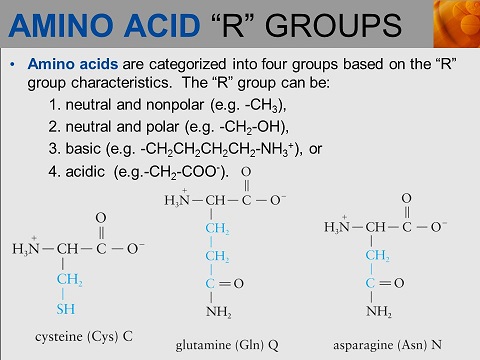page 1
~ The Study of Threes ~
http://threesology.org
Visitors as of 4/06/2023
| The Triplet Code 1 | The Triplet Code 2 | The Triplet Code 3 | The Triplet Code 4 |
Like several home pages before, let me begin by offering a few links:
Here are three links for Dr. Dundez's article "The Number Three in the American Culture" which appeared in an old 1967-1968 book entitled "Every Man His Way" (which is a collection of different Cultural Anthropology readings):
And let me acknowledge the greatly valued assistance of Simon Kelsey whose own research and exploration efforts into the Threes Phenomena has offered invaluable insights and provided numerous links from which were derived ideas that have led to a greater understanding. I am indebted to him. I provide a reference to his 3-to-1 idea received via e-mail: It’s interesting (wittingly or otherwise) that you refer to 3+1. This is what I refer to as triune, literally 3:1. The "THREE" realm is more: Abstract, Contextual, Analytical & Theoretical. It is primarily about Understanding. However the "ONE" realm is: Concrete, Objective, Synthetical & Practical. And it’s primarily about Achieving. The relevance of this is that as I am trying to put triune into action through design, I’m more & more drawn to ONE, bringing together, synthesis, unification, integration & oneness. It’s a question of emphasis. The three is implicit & always there, but if the goal is achievement, then the number is ONE. Switching back to understanding, however, this results in another set of triunes:
|
Note: there are many models of a "triplet code" in that patterns-of-three occur in many different subject areas. But like so many patterns, they are not collated into a collection which then approximates some theoretical consideration involving the different formulas thereof (numerical, word, geometric, etc...), which can be differentially perceived by our different sense "organs", including those which may occur to only a few in stark or subtle ways, such as the concept "subtle energies". Sometimes the "triple" profile is pretty straight forward and at other times it requires a bit of expansion beyond the conventions of typical pattern association... such as using a 'comparative subject' approach and then relating the whole to some centralized processing such as human cognition which has its many different influences... but nonetheless tend to create an atmosphere of limitation... of conservation in our usage.
One of these conventions is to think in terms of a double-stranded configuration when it has been found that there exists a quadruple configuration. Perhaps some future day with a different technology and/or mind-set we will also find an eight-stranded variation. As it stands, we have the following models involving the following 3-to-1 ratio of variations:
 |
i-Motifs are four-stranded DNA secondary structures which can form in sequences rich in cytosine. Stabilized by acidic conditions, they are comprised of two parallel-stranded DNA duplexes held together in an antiparallel orientation by intercalated, cytosine–cytosine+ base pairs. By virtue of their pH dependent folding, i-motif forming DNA sequences have been used extensively as pH switches for applications in nanotechnology. Initially, i-motifs were thought to be unstable at physiological pH, which precluded substantial biological investigation. However, recent advances have shown that this is not always the case and that i-motif stability is highly dependent on factors such as sequence and environmental conditions.  |
In this page let us turn our focus to the "Triplet Code" now widely recognized as being a constituent part of both DNA (deoxyribonucleic acid) and RNA (ribonucleic acid). While they are both ribonucleic acids, DNA has one oxygen molecule less that may or may not refer to the oxygen level of the Earth's early environment so many billions of years ago when DNA was being developed— the idea of an "RNA world first" notwithstanding. With respect to the development of oxygen and its later increase on Earth, those who indulge in having an aquarium become familiar with those plant species particularly useful in oxygen production, and those animal species which thrive in such enclosed (protective/isolated) environments (... i.e. "timeless niches"):
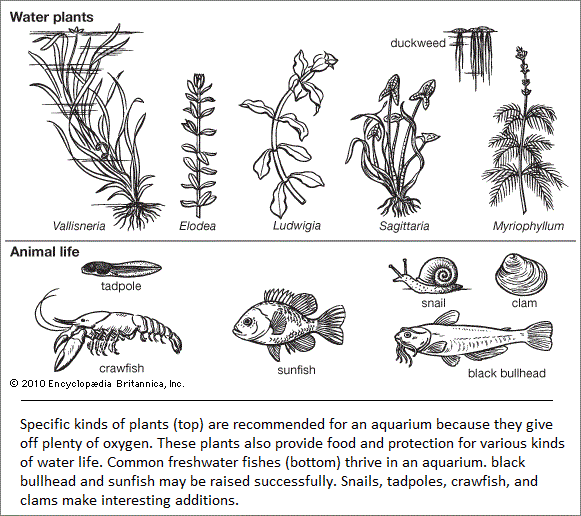
Nonetheless, when someone asks a biologist or geneticist to explain why their exists a triplet code instead of some other number value, a typical response is to say:
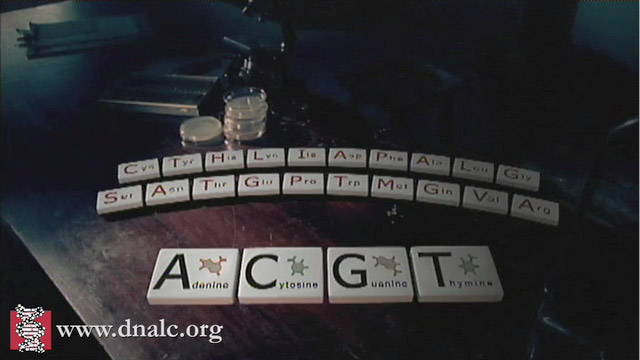
Once the DNA double helix had been discovered, the next big challenge was to work out how the four letters of DNA could code for each of the twenty amino acids that make protein. The first question was how many DNA letters coded for each amino acid? If it was one DNA letter for one amino acid then you could only code for a maximum of four amino acids. Two letters in every possible combination could code for up to sixteen amino acids. Still, not enough. But three DNA letters provide more than enough combinations to code for all twenty amino acids. So three was the answer. It was a triplet code. |
While for some readers the above is a definitive answer, from a Threesological point of view... I like to flip this idea around and say that the number of amino acids is the result of a triplet scaffolding that came to be erected and the development of amino acids were forced to accommodate this structure. Hence, the present reasoning in genetics and biology is simply backwards, just like the once held "official" idea that the Sun revolved around the Earth. However, this metaphor appears to agree with the old notion in that if we label the Earth with the 'triplet' designation due to its third position, while the Sun and the other planets being viewed as the amino acids... then we do in fact have them revolving around the Earth since they are beholden to the triple form of scaffolding which determined the limitation of overall amino acids, not to mention the fewer list of those necessary for our bodies since they can not be manufactured internally. However, in casting the "Triplet code" into the lime-light of the present discussion, let us not forget to mention that amino acids are paired on a metaphorized rung-like ladder.. except in the case of a single strand where the metaphor doesn't work too well.
While on the subject of pairing let us mention the notion of "wobbling" which generally refers to a non-standard (i.e. third) amino acid that may be used instead of the more common pairing. Here are some references:
|
Wobble in the Genetic Code
According to the genetic code, the cell would need tRNAs with 61 different anticodons to complement the
available 61 codons. However, due to the degeneracy of the genetic code, the third base is less
discriminatory for the amino acid than the other two bases. This third position in the codon is referred
to as the wobble position. At this position Us and Cs may be read by a G in the anticodon. Similarly, As
and Gs may be read by a U or y (pseudouridine) in the anticodon. | |||||||||||||||||||
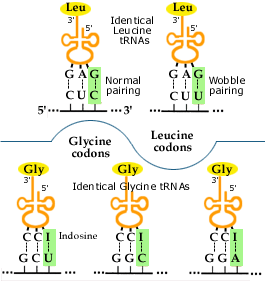 |
| ||||||||||||||||||
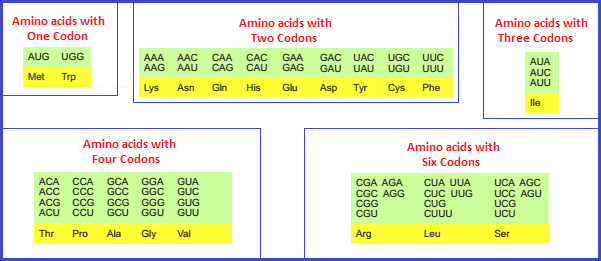 Nobel Prize.org | |||||||||||||||||||
Generally speaking, amino acids can be grouped into several different two or four-patterned ways that we can describe either as representative models of limitation or conservation related to environmental influences that appear to be undergoing an incremental deterioration due to planetary events humanity can't do anything about. In other words, though some readers may focus primarily on the "three" denoted by a triplet code, a Threesological point of view is inclined to see where "accessory" (non-three) patterns occur in relation to the "three", in order to discern whether or not they are part of yet another pattern-of-three such as a "2-3-4" sequence that may alternatively be recognized as a 3-to-1 ratio if another number (1 or 5 or non-numerically sequential) is sighted.
When speaking of limitation or conservation, the idea of genetic code "degeneracy" may come to mind. It can be defined for example as:
- A code in which several code words have the same meaning. The genetic code is degenerate because there are many instances in which different codons specify the same amino acid. A genetic code in which some amino acids may each be encoded by more than one codon. Degenerate code definition
- Degeneracy of codons is the redundancy of the genetic code, exhibited as the multiplicity of three-base pair codon combinations that specify an amino acid. The degeneracy of the genetic code is what accounts for the existence of synonymous mutations. Codon Degeneracy
- In the context of making and analyzing codes, the term “degeneracy” refers to having excess codes that produce the same message. A non-degenerate code, like Morse code, is one for one: each code is unique, producing one and only one output. The genetic code, by contrast, is many-to-one in some cases. For instance, six different codons can produce the amino acid leucine. This would be like having six combinations of dots and dashes to produce the letter A in a "degenerate" version of Morse code. Other amino acids can be coded by 4, 3 or 2 codons, while two (methionine and tryptophan) each have only one unique code. Evolution News and Science Today
Instead of "degeneracy" one might conjure another word such as for example "unstable". Much like we find three general classes of atomic particles as stable- unstable- highly unstable, one might also do this for amino acids. In any respect, the instability coupled to a circumstance of limitation says something about the environmental conditions all of biology is being subjected to. The "degeneracy" is like taking advantage of possible alternatives, like someone cast into a desperate situation having to become a generalist at times, instead of relying on a specificity of ability or resources. Whereas the genetic code at present is fairly stable, this may not be the case as we venture forward in time towards more unstable conditions such as over-population, severe weather conditions, political turmoil, etc... not to mention the burning out of the Sun, slowing rotation of the Earth, and receding of the Moon.
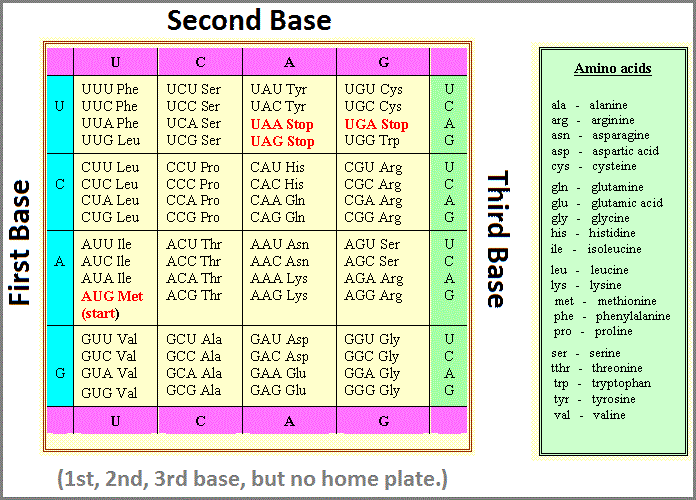
Resources:
How Genes Function
Amino Acids Are Encoded by Groups of Three Bases Starting from a Fixed Point
While some readers may find it useful to use the presence of an other-than-three occurrence to refute the notion of a "threes" occurrence as some sort of undistinguished rule-of-thumb which keeps cropping up, it is necessary for us to consider that the recurrence of ALL the number references which can be compiled are a model representing a consideration we are overlooking as an environmentally influenced specificity that is subject to change... and is presently changing on subtle levels... due to ongoing incremental environmental deteriorations that life is forced to adapt to, and we use "rationalized adjustments" in our belief systems as a means to shrug off the obvious... the obvious once it is recognized.
Hence, a 2, 3, 4 formula of modeling for the same information is linked to perception... a perception that is governed by an environmentally enforced conservation of enumeration... or whatever labels of symbolism we use. Whereas we humans can develop different enumerated models according to our preferenced perceptions of a given subject's information, all the models put together represent a limitation... a conservation whose cause needs to be looked more closely at. If it is environmental, and the environment is incrementally deteriorating, we need to identify the factors related to the type and degree of deterioration taking place and not simply shrug it off and claim that it will occur (as if due to a regulated slow pace) over a long period of time we need not be worried about or even research. This attitude is a "much, more, many" type of linguistic form of primitive counting like looking at the stars and saying their are billions of them, but then have no interest in studying them except to create romanticized references to such in poems, art, music, etc...
While some readers may like to refute the recurrence of the "three" cropping up in different situations as a mere coincidence, it is a particularly large coincidence which appears in theories representing different types of origins and/or subsequent activities, including the demise of the Universe... as described in the following U-Tube:
Here are a few two-patterned references noted when reading about amino acids while involved with chemistry:
- positive/negative charges
- acid/base
- polar/non-polar
- amino/carboxyl R-groups
- Neutral/polar
- Neutral/non-polar
- L (Levorotary- rotating left... counter-clockwise)/ D (Dextrorotary- rotating right... clockwise] All naturally occurring amino acids exist as L-amino acids.)
- Enantiomer: Either one of a pair of compounds (crystals or molecules) that are mirror images on each other but are not identical: Wordweb dictionary.
Another problem... that is, a non-"3" specific pattern showing itself during a "threes" research exploration, is that the standard "Triplet Code" reference of DNA and RNA actually reflects the presence of 3-to-1 ratios, in that each of them has Adenosine, Cytosine, Guanine, and their discriminators respectfully called Thymine (for DNA) and Uracil (for RNA):
| ~ Item ~ | ~ Three the same ~ | ~ One is different ~ |
| DNA = | Adenosine- Cytosine- Guanine | Thymine |
| RNA = | Uracil |
Source: Let's Talk Peace page 2
Having three that repeat is like having a mathematically definable set. An example of this is the standard usage of (ones-tens-hundreds) followed by a comma in order to distinguish the beginning of yet another set noted as (thousands-ten thousands-hundred thousands). It is a set-of-three followed by a comma (as a point of demarcation) used to designate the beginning of a potential new set-of-three, even if only the first place in thousands is used.
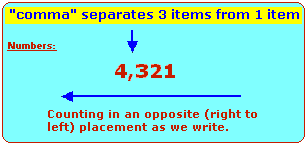
Three additional number patterns you may or may not have included in your "threes" list:
- Three are different: 1st, 2nd, 3rd... the rest are the same: 4th, 5th, 6th... (th-ending)
- 24/7/365 (24 hours a day, 7 days a week, 365 days in a year): The numbers 1-8-9 are missing.
- "Once" (Oice?)- Twice (Twonce?)- Thrice (Thronce?)... (after these three 'rhyming' similarites, there is the "s" in sixth-seventh, an absence in 8, 9, 10, ll, 12) followed by the "teens" and then the repetitions according to the segmented values of "twenty...1, 2, 3, etc...", thirty..., forty, etc., though "thirty and forty" exhibit a similarity of sound.
In looking at number "sounds", we have to research not only language and the physiological mechanics of its verbal production, but also the underlying mechanisms involved in the auditory processes, because hearing is a vital component as noted when a deaf person attempts to articulate.
|
| |
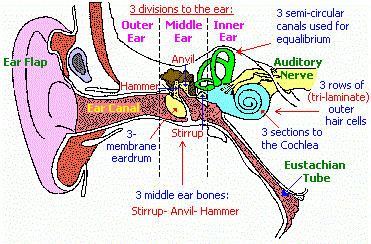 | |
| 3 overall divisions: | Outer ear~ Inner ear~ Middle ear |
| 3 middle ear divisions: | Tympanum~ Epitympanum~ Mastoid antrum |
| 3 eardrum membranes: | Cutaneum~ Collagen fibers~ Mucosm |
| 3 semi-circular canals: | Used for balance (equilibrium) |
| 3 bones: | (ossicular chain) Incus~ Stapes~ Malleus |
| 3 main malleus ligaments: | Anterior~ Lateral~ Superior |
| 3 incus anchorage points: | Malleus~ Stapes~ Bony fossa wall |
| 3 cochlea sections: | (Scala) Vestibuli~ Tympani~ Cochlear duct |
| 3 extrinsic muscles (Auricularis): | Anterior~ Superior~ Posterior |
| 3 sound conduction paths: | Electrical~ Mechanical~ Fluid or: Bone (solid)~ Air (gas)~ Fluid (liquid) |
| 3 nerve stimulation paths: | Mechanical~ Chemical~ Electrical |
| 3 outer hair cell rows |
typical in mammals but some sources give 3, 4, or 5 |
| Neurotrophin-3 (NT-3) is synthesized by inner and outer hair cells of the developing organ of Corti. | Brain-derived neurotrophic factor (BDNF) is also synthesized. (Prestin is the motor protein of the outer hair cells.) |
| 3 sound qualities: | Pitch~ Volume (intensity)~ Tone |
| 3 sound wave propagation processes: | Diffraction~ Transmission~ Reflection |
| 3 main forms of ossicular chain fixation: | Fluid~ Mechanical~ Otosclerosis |
| 3 classes of ossicular lever action: | Force arm~ Resistance arm~ Fulcrum |
| 3 acoustic distortion forms: | Frequency~ Phase~ Amplitude |
| 3 basic properties of vibrating bodies: | Inertia~ Elasticity~ Dissipation |
| 3 principal types of deafness: | Conduction~ Nerve~Stimulation |
| 3 types of hearing loss: | Conductive~ Sensorineural~ Mixed |
| 3 (inner ear) organs of balance: | Semicircular canals~ Utricle~ Saccule (collectively called the vestibular organ, which can be referred to as a {3-in-1} ratio.) |
Let's Talk Seriously About Peace page 2
Language 3's page 1
Page Originated: Saturday, 7th April 2018... 7:53 AM
Initial Posting: Thursday, 12th April 2018... 10:57 AM
Updated Posting: Saturday, 22nd June 2019... 8:28 AM
